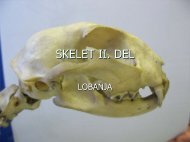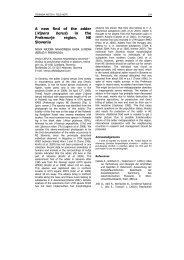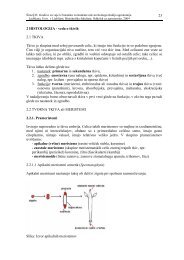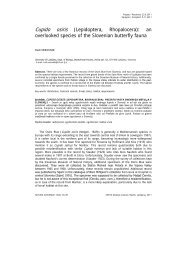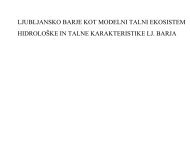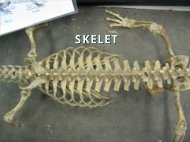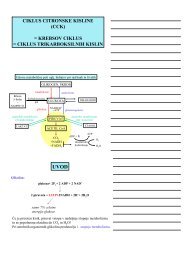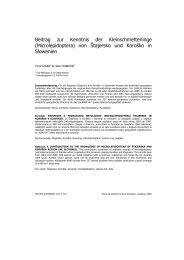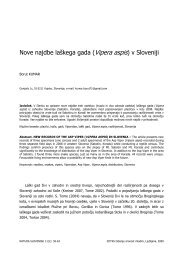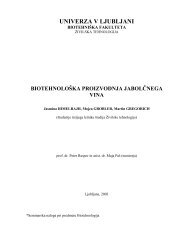Global diversity of leeches (Hirudinea) in ... - Univerza v Ljubljani
Global diversity of leeches (Hirudinea) in ... - Univerza v Ljubljani
Global diversity of leeches (Hirudinea) in ... - Univerza v Ljubljani
Create successful ePaper yourself
Turn your PDF publications into a flip-book with our unique Google optimized e-Paper software.
130 Hydrobiologia (2008) 595:129–137<br />
Fig. 1 Habitus <strong>of</strong> three typical representatives <strong>of</strong> major<br />
hirud<strong>in</strong>ean taxa: (A) Cystobranchus fasciatus, a fish leech<br />
(Piscicolidae), dorsal view; (B) Placobdella costata, a glossiphoniid,<br />
dorsal view; (C) – Barbronia assiuti, an<br />
erpobdelliform, lateral view; (D) Ventral view <strong>of</strong> the clitellum<br />
with genital and accessory open<strong>in</strong>gs; the latter are found only<br />
<strong>in</strong> some species. os––oral sucker, cs––caudal sucker, mgo––<br />
male genital open<strong>in</strong>g; fgo––female genital open<strong>in</strong>g. Orig<strong>in</strong>al<br />
draw<strong>in</strong>gs are a courtesy <strong>of</strong> Hasko Nesemann<br />
Species <strong>diversity</strong><br />
This compilation was greatly facilitated by some<br />
previous local or global monographs, ma<strong>in</strong>ly <strong>in</strong>directly<br />
through Sawyer (1986); beside the latter, such<br />
are by Hard<strong>in</strong>g & Moore (1927), Klemm (1972),<br />
Luk<strong>in</strong> (1976), R<strong>in</strong>guelet (1980), Yang (1996), Nesemann<br />
& Neubert (1999), and a series by Soos (1965–<br />
1969). Numerous primary sources (not listed <strong>in</strong><br />
References) were used to complete the work.<br />
123<br />
L<strong>in</strong>naeus (1789) described 14 species <strong>of</strong> Hirudo,<br />
classified as Vermes Intest<strong>in</strong>a. The classical taxonomy<br />
used to be based on the general shape, color<br />
pattern, position and number <strong>of</strong> eyes, later also on<br />
distance between genital open<strong>in</strong>gs. Moqu<strong>in</strong>-Tandon<br />
(1846) presented anatomical pictures which were<br />
later used extensively; so was also the system <strong>of</strong><br />
annulation with an appropriate cod<strong>in</strong>g, proposed by<br />
Moore (1898). Pawlowski (1948) added the male<br />
atrium shape. However, nobody assessed the variability<br />
level <strong>of</strong> the morphological and anatomical<br />
characters. A study <strong>of</strong> the hirud<strong>in</strong>ean <strong>diversity</strong> <strong>of</strong> the<br />
former Yugoslavia area, notorious for its complex<br />
bio<strong>diversity</strong>, showed that neither the anatomy <strong>of</strong> the<br />
reproductive apparatus nor the annulation is stable<br />
enough to be reliable, as character above the species<br />
level (Sket, 1968). This, and some phylogenetic<br />
uncerta<strong>in</strong>ties, triggered first molecular studies (Trontelj<br />
et al., 1996; Siddall & Burreson, 1998) followed<br />
by many others that are nowadays yield<strong>in</strong>g surpris<strong>in</strong>g<br />
solutions predict<strong>in</strong>g discovery <strong>of</strong> further unexpected<br />
errors <strong>of</strong> the current taxonomy.<br />
However, morphological means allowed us to<br />
describe approximately 680 species till now, some<br />
480 <strong>of</strong> which are freshwater. Bielecki (1997) <strong>in</strong>troduced<br />
new detailed morphological and anatomical<br />
standards <strong>in</strong> the systematics <strong>of</strong> piscicolids (fish<br />
<strong>leeches</strong>) that gave rise to a manifold <strong>in</strong>crease <strong>of</strong><br />
European fish leech species. This, along with a<br />
considerable ‘cryptic’ <strong>diversity</strong> among European<br />
erpobdellids (own studies, unpublished), suggests<br />
that a large number <strong>of</strong> species has still rema<strong>in</strong>ed<br />
unrecognized even with<strong>in</strong> the traditionally beststudied<br />
European hirud<strong>in</strong>ean fauna. The cumulative<br />
plot <strong>of</strong> described species (Fig. 2) shows no sign <strong>of</strong> a<br />
plateau.<br />
These facts also imply that leech taxonomy––at<br />
the species level and higher––is <strong>in</strong> a revolutionary<br />
phase right now. In the present overview (Table 1),<br />
we ma<strong>in</strong>ly follow the system <strong>of</strong> Sawyer (1986) but<br />
we could not ignore some novel f<strong>in</strong>d<strong>in</strong>gs; therefore,<br />
some <strong>of</strong> our solutions are partial and<br />
provisional. Too little care has been taken till<br />
now to represent genera <strong>in</strong> molecular studies by<br />
their type species and species by their topo-type<br />
populations, as these are the only reliable means<br />
for assur<strong>in</strong>g the taxonomical identity <strong>of</strong> objects.<br />
Neither the number <strong>of</strong> families, nor their generic<br />
subdivision, are f<strong>in</strong>al.



